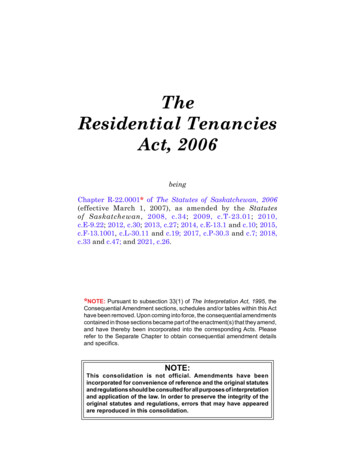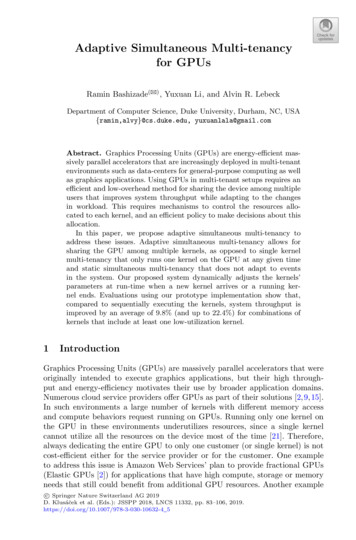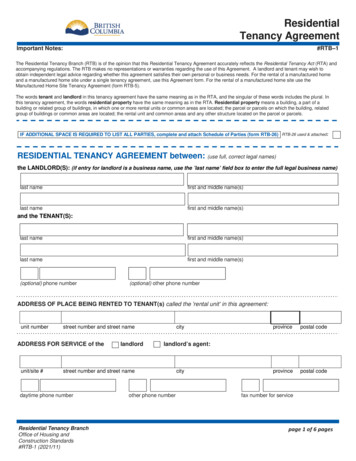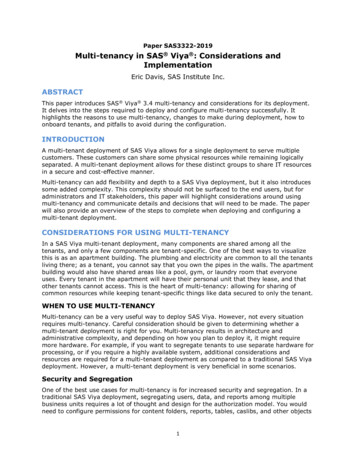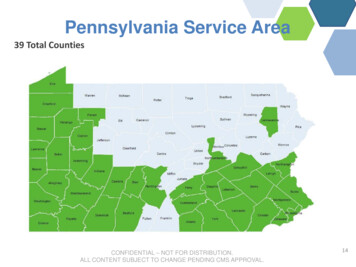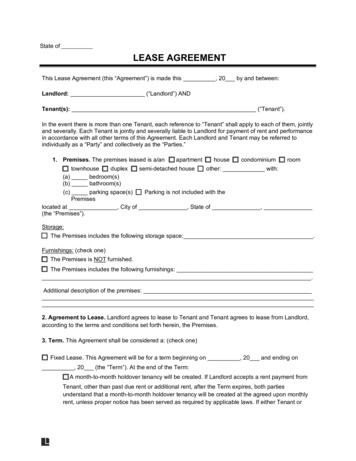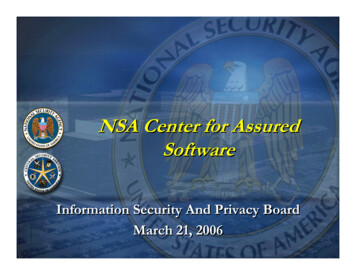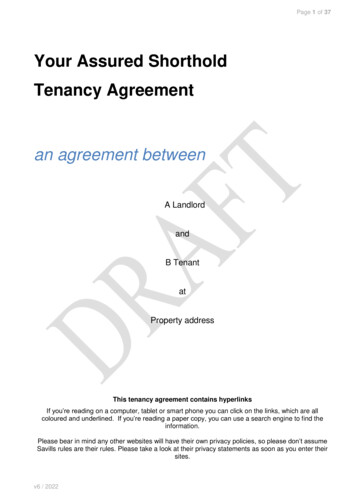
Transcription
Page 1 of 37Your Assured ShortholdTenancy Agreementan agreement betweenA LandlordandB TenantatProperty addressThis tenancy agreement contains hyperlinksIf you’re reading on a computer, tablet or smart phone you can click on the links, which are allcoloured and underlined. If you’re reading a paper copy, you can use a search engine to find theinformation.Please bear in mind any other websites will have their own privacy policies, so please don’t assumeSavills rules are their rules. Please take a look at their privacy statements as soon as you enter theirsites.v6 / 2022
Page 2 of 37What’s in this tenancy agreement?ContentsSection Why have a tenancy agreement Definitions and interpretations words with special meanings The main conditions and Tenancy ParticularsA Costs and other Charges Tenant obligations B Before the start of the tenancy, and where relevant during Shared obligations C Tenant obligations D Landlord obligations E Guarantor obligations F G H During the Tenancy Tenant obligations To do and not to do Landlord obligations Specially negotiated clauses . . Provisions for re-entryI .J At the end of the Tenancy Shared obligations K Tenant obligations L Landlord obligations MStoring, handling and sharing personal data Signingv6/2022N
Page 3 of 37This tenancy agreement defines the Landlord and Tenant’s roles,responsibilities and liabilities before the start and throughout thewhole of this TenancyYour first step is to Agree and Accept all the terms, conditions andobligations set out within this agreement.Once you’ve read everything within this tenancy agreement, along with any other documents referredto, and are satisfied that you understand and are happy with the content please sign this document asyour confirmation that you’d like to go ahead with and be legally bound by the terms of the Tenancy.If any clause refers to something that is not at/or in the Property, for example, clean chimneys wherethere are none, the clause is not applicable, but will remain in this agreement.If there is anything you don’t understand you should get independent legal advice from a solicitor or anyother advice agency before you sign. You can also visit www.direct.gov.uk for more information.This agreement will be legally binding only once references are approved, the Agent has confirmationof Cleared Funds, the tenancy agreement has been signed by both Parties and dated, and the Propertyis vacant and ready to be moved into.The Tenant is responsible for any breach to this tenancy agreement caused by themselves, any OtherOccupier, licensee or Visitor to the Property. When there are two or more Tenants, they have Joint andSeveral Liability and the Landlord can pursue one or all of them for any breach.It’s agreed and accepted that any amendments to the standard clauses of this agreement (whethernoted by hand, electronically, or by any other means) by any party, will not be binding unless included,by the Agent, as specially negotiated clauses in section I of this tenancy agreement or any clauses thatcorrect an error or are specially negotiated and confirmed in writing subsequently.Where this tenancy agreement states that consent is needed, the Tenant must always get the consentin writing (email or letter) from the Landlord or their Agent.This tenancy agreement falls under the laws of England andWalesThe laws of England and Wales apply to this tenancy agreement, and the courts of England andWales have exclusive jurisdiction.v6/2022
Page 4 of 37Definitions and interpretationsBecause this tenancy agreement is a legal contract, some of thewords used have a particular or ‘extended’ meaning. We’veexplained these below. Each of these words will be started witha capital letter throughout this contract, and you can refer to thispage to remind you of the meanings.If anything about these definitions isn’t clear, or you’d like todiscuss them in more detail, please contact Savills.Additional Clauses: Specially negotiated by Savills between all Parties named within this tenancy agreementto record the variations or ‘special’ agreements that have been agreed by the Parties and are detailed in sectionI of this tenancy agreement. These clauses can’t be classed as unfair unless unlawful or they contradict statute.Agent: Will be Savills (UK) Limited or any other Agent appointed by the Landlord from time to time to managethe Property. If there is a change of Agent the Landlord will notify the Tenant in writing.Agree and Accept: Once this tenancy agreement is legally binding, any named Parties will be in breach of its’conditions if they don’t comply with all of the obligations agreed and accepted.Appliance: These are generally devices or equipment designed to perform a specific task for example, acooker, washing machine and electrical items. This does not include a television or integrated sound system.Cleared Funds: Any monies that have cleared through the bank and are available for use.Client Account: Is a bank account where Savills (UK) Limited acting as the Agent holds any funds to the creditof either the Landlord or the Tenant. Funds held in this account are protected in line with the Client MoneyProtection rules. Savills (UK) Limited are a member of an approved Client Money Protection Scheme providedby RICS (Royal Institute of Chartered Surveyors). Additionally where this tenancy agreement is an AssuredShorthold Tenancy any Deposit held by Savills is also subject to the Tenancy Deposit Scheme operated by theTenancy Deposit Scheme.Common Parts (flats and/or apartments): External walls and load bearing walls, foundations, columns,beams and other structural supports. Walls enclosing passageways, corridors and staircases. Any chimneys,roof, gables, gutters, lightning conductors, satellite dishes and associated equipment, aerials and aerial cables.Costs, Charges, Expenses, Payments: Money, which is due or becomes due for payment by either theLandlord or the Tenant and will be Reasonable to the sum of money charged.Deposit: A Deposit payment paid usually by the Tenant, which the Landlord or their Agent (as Stakeholder)hold for the duration of the Tenancy in line with section C clause 5.Fair Wear and Tear: Considered to be Reasonable use of the Property by the Tenant and the ordinaryoperation of natural forces. When any damage is noted on the check-out report it will have taken into accountthe length of the Tenancy, the number and ages of the Tenants, the number and breed of any pets, the quality,condition and age of an item when the Tenant moved in along with its average expected life span.Flammable: Also means inflammable and combustible. This covers anything that is capable of being set fire toor anything that is easy to set fire to.Fixtures and Fittings: Includes any: Fixtures (generally any item that is fixed for example to floors, walls orceilings), Fittings (generally any free standing item or hung by a nail or hook), furniture, effects, floor, ceiling orwall coverings, and equipment and appliances belonging to the Landlord.Guarantor: Is the person who agrees to pay the Rent in full if the Tenant does not, and also agrees to indemnifythe Landlord or their Agent for any default or breach of this tenancy agreement by the Tenant including anydamage, non-payment of bills and so on.v6/2022
Page 5 of 37Head Lease: The Lease under which a Landlord owns a Property where they don’t own the freehold. This isalso known as or referred to as a superior lease.Inventory and Schedule of Condition: A document created by the Landlord or independent inventory clerk,which records the Property, Fixtures and Fittings and any contents. The condition and cleanliness may also becommented upon. It should be checked at the start of the Tenancy and again at the end and any check-in andcheck-out reports will summarise the key findings including conditions and cleanliness. The Tenant should tellthe Landlord or their Agent immediately if there is anything in either report that they do not agree with.Otherwise, the Tenant should sign and return a copy of the check-in report to the Landlord’s Agent as soon aspossible. Some inventory clerks will complete the Inventory and Schedule of Condition and check-in report atthe same time.Joint and Several Liability: Where there are two or more named Tenants, Guarantors or Landlords they will be‘jointly and severally liable’ for their respective obligations. That means for example, the Landlord can take legalaction against any, or all, of the Tenants and/or Guarantor for any breach of the agreement by any of them.Each Tenant and any Guarantor is also responsible for their fellow Tenants’ share of the Rent and otherobligations.Landlord: Any individual owning an interest in the Property, whether freehold or leasehold, including any owner,person, party, firm, company (including a limited liability partnership) or entity who is entitled to the immediatepossession after the end of the Tenancy.Lead Tenant: This will be the nominated person who acts on behalf of all Tenants (where there are multipleTenants), when dealing with the Deposit on the conditions set out in section C clause 5 of this tenancyagreement. All Tenants agree to the appointment of the Lead Tenant who then has authority to discuss andagree matters with the Landlord or their Agent. If no Lead Tenant is specified and unless otherwise agreed inwriting then the first or only named Tenant on the ‘Tenancy Particulars’ page will be the Lead Tenant. At theend of the Tenancy, the Lead Tenant becomes the first person to log into the Tenancy Deposit Scheme websiteto raise or respond to any dispute.Notices: If the Landlord wants to serve any Notice in line with the terms of this tenancy agreement or in line withany legislation and/or regulations relating to this Tenancy they will do so in line with the rules set out by the Lawof Property Act 1925. Notice can be posted, hand delivered or emailed.By post: when a Notice is sent by ordinary first class post to the Tenant at the Property, or their lastknown address it’ll be deemed delivered two working days (which excludes Saturdays, Sundays andBank Holidays) after the day of posting. It’ll be deemed served the next working day and this is whenthe term of the Notice for possession can begin.By post example:If posted on a Tuesday it will be deemed delivered on Thursday and the term of any Notice forpossession can begin from the Friday (the next working day) when it’ll be deemed served.By hand: when a Notice is delivered by hand and left at the Property (addressed to the Tenant) it’ll bedeemed delivered on the same working day as it’s delivered as long as it’s left at the Property before5pm (UK time) on that day (excluding Saturdays, Sundays and Bank Holidays). It’ll be deemed servedthe next working day and this is when the term of the Notice for possession can begin.By hand examples:If delivered through the door of the Property or into the letter box for the Property before 5pm on aTuesday it’ll be deemed delivered that day and the term of any Notice for possession can begin on theWednesday (the next working day) when it’ll be deemed served.If it was delivered through the door of the Property or into the letter box for the Property after 5pm on aTuesday it’ll be deemed delivered the next working day (Wednesday) and the term of any Notice forpossession can begin on the Thursday (the next working day) when it’ll be deemed served.By email: Provided that neither the Landlord or their Agent nor the Tenant has stated in writingthat they will not accept service of documents by email the Parties agree that documents may be servedby email. Any Notice served by email will be deemed delivered (provided that it is sent to the last emailaddress provided by any party and it doesn’t get rejected or ‘bounce back’) on the same working day assent. Providing it is sent before 5pm on that day (excluding Saturdays, Sundays and Bank Holidays).The term of any Notice for possession can begin the next working day when it’ll be deemed served.v6/2022
Page 6 of 37By email examples:If emailed before 5pm on a Tuesday it will be deemed delivered on that day and the term for any Noticefor possession can begin on the Wednesday (the next working day) when it’ll be deemed served.If emailed after 5pm on a Tuesday it will be deemed delivered the next working day, Wednesday, andthe term for any Notice can begin on the Thursday (the next working day) when it’ll be deemed served.If emailed after 5pm on a Friday it will be deemed delivered the next working day, Monday, and the termfor any Notice can begin from the Tuesday (the next working day) when it’ll be deemed served.Other Occupiers: These are other people that may be allowed to live in the Property during the Tenancy, if thishas been agreed with the Landlord and detailed in this tenancy agreement, such as the Tenant’s children orother dependants and any staff. These types of people don’t need their full names on the tenancy agreementbut they must be noted, for example as housekeeper, or chef, or three children under the age of 18. Anyoneelse, who’ll be aged 18 or over whilst living at the Property, falls into the category of permitted occupier, their fullnames must be included on the tenancy agreement. Any person over the age of 18 must have their Right toRent in the UK checked.The Landlords needs to agree before any additional people move in.The Tenant cannot grant exclusive possession of part of the Property to another person, as this would beclassed as subletting and a breach of this agreement.Parties: The Landlord and/or the Tenant and/or any Guarantors.Plural References: This also means singular, any singular references also cover plural.Professional Standard: A high standard of work, which would be expected from a good competent contractor.Property: The building together with any annexes, land, outbuildings, boundaries, fences, gardens belonging tothe Landlord; unless they have been specifically excluded from the Tenancy. When the Property is part of alarger building, the Property includes Reasonable use of Common Parts, access ways and facilities.Quiet Enjoyment: Means that the Tenant has the right to live in the Property, as their home, withoutinterference from the Landlord or anybody else.Reasonable: Fair, proper, moderate and appropriate under the circumstances. For example, this may take intoaccount factors such as weather conditions, age of an item, bank holidays and/or length of the Tenancy and soon.Rent: A Tenant’s advance payment to a Landlord for the use of the Property as specified on the ‘TenancyParticulars’ page.Right to Rent: Before a Landlord can allow anyone over the age of 18 to rent and live in their Property inEngland they or their Agent must check they have a valid immigration status and are permitted to live in the UK.(See: Government short guide on Right to Rent).Singular References: These also means plural, any plural references also cover singular.Stakeholder: Where the Agent or another person or body holds the Deposit as an independent third party onthe terms set out in the Deposit clauses in this tenancy agreement. No deductions can be made from theDeposit without consent from both Parties, or from the court, or an adjudication decision from the TenancyDeposit Scheme.Superior Landlord: The person (if any) who owns the interest in the Property which gives them the right topossession of the Property at the end of the Landlord’s lease of the Property.Telecom/s: Telephone (landline and/or mobile), satellite, cable and broadband services.Tenancy Deposit Scheme: means the Tenancy Deposit Scheme operated by The Dispute Service Ltd asdetailed in the Prescribed Information.Tenancy Particulars: Important notes about this tenancy agreement.v6/2022
Page 7 of 37Tenant: The person/people to whom the Landlord grants a temporary and exclusive use of the Property inexchange for Rent.Tenant-Like Manner: There is a legal duty on Tenants to avoid, or repair, wilful or negligent damage caused bythem, their family members or guests and to do the things necessary to keep the Property in a Reasonablestate. This includes jobs such as changing light-bulbs, unblocking sinks (where the blockage has been causedby the Tenant’s waste), taking Reasonable steps to keep the Property adequately ventilated and heated so as toprevent damage from condensation, disposing of all rubbish correctly, as well as doing other jobs around theProperty that, a Reasonable Tenant would do. The Tenant must take Reasonable care of the Property, anyitems listed in the Inventory and Schedule of Condition and the Common Parts (if any).The “Term” or the “Tenancy”: The period for which this Tenancy is granted together with any extension, rollon, holding over or continuation of the Tenancy, including any statutory periodic Tenancy arising after the expiryof the original Term.Utility, Utilities or Utility Supplier: This includes the suppliers/providers and collectors of gas, electricity, water(including sewerage & wastewater) and all fuels.Vacant Possession: To leave the Property empty and free of people, rubbish, and furniture and contents notbelonging to the Landlord as well as leaving it cleaned to a Professional Standard and in a state fit to beoccupied.Visitor: Anyone other than the Tenant or Other Occupiers who enters the Property.Water Charges: Includes water as well as sewerage and environmental service Charges.v6/2022
Page 8 of 37The main conditionsThis section of the agreement sets out the conditions which areparticular to this tenancy agreement.Whilst the whole tenancy agreement is important, it’s essentialthat all Parties listed below understand, and are content, with theterms, conditions and obligations agreed in this section. Bysigning the tenancy agreement all Parties Agree and Accept them.A.Tenancy ParticularsDate:1.This Assured Shorthold Tenancy agreement is between the following Parties:“The Landlord”:insert namesOf insert address:and“The Tenant”:insert namesOf insert address:and“The Guarantor”:insert namesOf insert address:All Parties named as the Tenant or the Guarantor will be held jointly and severally liable under thisagreement.2.Other OccupiersThe Landlord Agrees to, and Accepts that in addition to the Tenant the following persons (who are notclassed as Tenants) may live at the Property with and as invited by the Tenant:a. The Tenant’s children or other dependents who are under 18 years of age at the start of theTenancy.b. Staff: Any full time employed ‘live-in’ domestic staff (insert their title e.g. au pair, housekeeper).c.v6/2022Permitted occupiers (if any): (insert any permitted occupier names).
Page 9 of 373.The Property and Common Parts:Address:4.Post Code:The Property includes:Parking:Garage:Outhouses:Outside space, gardens or grounds:5.The following areas or facilities are not included in this Tenancy:Excluded areas:6.Term and expiry of the fixed Term:The Tenancy created by this agreement,Starting from and including: [insert dates], this is the first day of this TenancyandEnding on and including: [insert dates], this is the last day of this Tenancy.Unless terminated early as detailed in section J regarding the Landlord’s reasons for possessionduring the fixed Term or as detailed in section I of this agreement.If the Tenant continues to live in the Property after the expiry of the fixed Term with theLandlord’s agreement and no further Tenancy has been agreed by the Parties, then from theexpiry of the fixed Term the Tenant shall occupy the Property under a statutory periodicTenancy in accordance with section 5(2) of the Housing Act 1988.Break Clause: Yes, and as detailed in section I of this tenancy agreement *This is to be anintuitive field and to come out if no break clause)7.Termination by the Landlord during or at the end of the fixed Term:If the Landlord wants the Tenant to leave the Property, the Landlord must:(a) Give the Tenant at least two months’ notice in writing by serving a section 21 Notice as per theHousing Act 1988 or(b) Seek possession on one or more of the Grounds contained in Schedule 2 of the Housing Act 1988.If the Tenant doesn’t leave by the date specified in the Notice the Landlord will need to apply to a courtfor a possession order. Only an officer appointed by the court can evict a Tenant.8.Address for Tenant serving Notice:To comply with sections 47 and 48 of the Landlord and Tenant Act 1987 the Landlord must tell theTenant the address at which Notices, including Notices of proceedings, may be served upon theLandlord:(1) if Savills are managing the Property the address is: Savills (UK) Ltd, Tenancy Terminations Team,One Church Road, Richmond-Upon-Thames, TW9 2QE, or(2) if there is no managing Agent then the address of the Landlord on the ‘Tenancy Particulars’ page oras subsequently notified in writing to the Tenant.v6/2022
Page 10 of 379.The Rent: [Rent Numeric] (& write Rent in words) per calendar month.The payment period of this Tenancy is monthly.10.{#Standard rent payment .Payment of the Rent by the Tenant:{#Monthly/Three Monthly /Six Monthly/Annually#} in advance in the sum of {#Rent Numeric#} {(#Rentin words#)}, the first payment to be cleared funds on or before the {#insert#} day of {#insert month &year#} and thereafter payment is to be cleared funds by {#due date#} of each {#month/three months/sixmonths/year.#}If payment is received from a third party appointed by the Tenant, they pay as ‘Agent on behalf ofthe Tenant’ with no rights to this tenancy agreement.Rental payment or other monies payable under this tenancy agreement can’t be withheld even if aDeposit or any part of it is being held. This means the Tenant must pay the Rent for every monthof the Tenancy, including the last month, and not defer to the Deposit held.#}{#If shortfall to pass references Payment of the Rent by the Tenant:As the Tenant references did not quite meet affordability a portion of rent will be paid in advance. Thiswill mean that the first payment will be [Rent Numeric] (Rent in words) to be paid on the (insert) day of(month) (year).Thereafter, from the (insert) day of (month) (year), the Rent payments will be [Rent Numeric] (& writeRent in words) per calendar month payable in advance on the (insert) day of the ((month/or on the(insert) day of every third/sixth month calculated from the first day of the Tenancy)).If payment is received from a third party appointed by the Tenant, they pay as ‘Agent on behalf of theTenant’ with no rights to this tenancy agreement.Rental payment or other monies payable under this tenancy agreement can’t be withheld even if aDeposit or any part of it is being held. This means the Tenant must pay the Rent for every month of theTenancy, including the last month, and not defer to the Deposit held.#}{#6-4-6 Payment of the Rent by the Tenant: [Rent Numeric] (Rent in words) in advance on the (insert) day of ((month) (year)) for the period(day/month/year to day/month/year). Thereafter payments shall be due as follows:Payable in advance on (day/month/year) for the period (day/month/year to day/month/year).Payable in advance on (day/month/year) for the period (day/month/year to day/month/year). #}If payment is received from a third party appointed by the Tenant, they pay as ‘Agent on behalf of theTenant’ with no rights to this tenancy agreement.Rental payment or other monies payable under this tenancy agreement can’t be withheld even if aDeposit or any part of it is being held. This means the Tenant must pay the Rent for every month of theTenancy, including the last month, and not defer to the Deposit held.#}11.Method of payment: By online banking, bank transfer or standing order.12.Deposit: The Deposit of [Deposit Numeric] (Deposit in words) is paid by the Tenant to the Agent to beheld by Savills as Stakeholder. Savills is a member of and subject to the requirements of the: 13.Tenancy Deposit Scheme (TDS)RICS Client Money Protection Scheme (CMPS)Tenant Initial payment of Rent and Tenancy DepositBarclays Bank plcSort Code: 20-79-41Account Number: 13235653v6/2022
Page 11 of 37Account Name: Savills (UK) Ltd Client AccountSavills bank details will not change, you must contact Savills immediately if you receive a notification topay anywhere else.14.Tenant UK bank details for any Deposit return:Tenant UK Bank account in the name of: Sort code: / / Account number: .Tenant UK Address for correspondence regarding the Deposit Return: . 15.v6/2022Agent: Savills (UK) Limited of [Office Address] (“Savills”)
Page 12 of 37Costs and other ChargesB.The Tenant Agrees and Accepts the following Costs andother Charges as part of the terms, conditions andobligations.1.Any Charge made, whether detailed specifically at this stage or not, will be Reasonable and will havebeen calculated to cover (indemnify) the Landlord or their Agent. Where detailed they are all shownincluding VAT.1.1If the Tenant requests any specially negotiated clauses that the Landlord agrees to after the tenancyagreement has been signed, the Agent will charge the Tenant up to 50 or for any Reasonable Costsincurred if these are higher than 50. No section of the tenancy agreement will have any clausesremoved, changed or added.1.2If any Rent Payments are late, returned or not paid the Landlord can charge the Tenant interest on thelate Rent, this will be charged from day 15 and you’ll be charged interest from the first day the paymentwas late at 3% above the base rate of Bank of England per year, calculated daily on the late Rent.1.3The Tenant will be charged one or both of the following default fees if they breach their obligations andor don’t pay Rent they owe under this tenancy agreement: Interest for late payment of Rent and/orReasonable Charges for lost keys.1.4The Tenant will indemnify the Landlord for all Reasonable Costs and/or Expenses incurred by theLandlord, their Agent or other professional advisors for the service of any Notice for obtaining, orenforcing the recovery of any Rent or any other money owed; or obtaining possession of the Property;or relating to any breach of the Tenant’s obligations within this tenancy agreement.1.5If any obligations are breached within this tenancy agreement by the Tenant, Other Occupier or anyVisitors the Tenant will indemnify the Landlord for damages and rectifying the breach. This includes callout services (including out of hours) and pre-agreed contractor visits where the contractor is unable togain access and they make a cancellation Charge.1.6To indemnify the Landlord or their Agent in respect of any loss arising from any claim as a consequenceof any breach by the Tenant of any of their terms, conditions and obligations in this tenancy agreement.1.7To indemnify the Landlord, in accordance with any Order of the Court, for damages in respect of anylegal Costs and Expenses incurred in enforcing this Agreement or any part of it and which arises from abreach of its terms by the Tenant.1.8To indemnify the Landlord or their Agent for any loss incurred resulting from the dishonouring of anycheque paid by the Tenant or a third party on their behalf or for any loss arising from the cancellation ornon-payment of a standing order payment by the Tenant or their bankers.1.9The Tenant Fee Act 2019 does not affect the Landlord’s entitlement to recover damages forbreach of the tenancy agreement by way of a deduction from the Tenancy Deposit or taking courtaction.2.Stamp Duty Land Tax (SDLT):2.1Pay to HM Revenue & Customs if the calculated Net Present Value of Rent paid over the wholeTenancy period including any extension is such that Stamp Duty Land Tax is payable on the grant orcontinuation of the tenancy. The figure used is cumulative meaning it may be two or three years into theTenancy that the Tenant may be liable for payment. Failure to pay could result in a fine to the Tenant.2.2The Tenant should visit the Governments SDLT page for further information, there is also a SDLTcalculator facility (you must follow the process as if you were buying a leasehold property).v6/2022
Page 13 of 37Landlord and Tenant responsibilities before the Tenancy startsC.Before the start of the Tenancy the Landlord and TenantAgree and Accept all of the following terms, conditions andobligations.1.Type of Tenancy:The Tenancy will be an Assured Shorthold Tenancy (AST), which means that the Landlord can onlyrecover possession of the Property (meaning they can only take the Property back) on certain Grounds.It is granted subject to the provisions for recovery of possession set out in section 21 of the Housing Act1988 as amended.Some of these Grounds require the Landlord to give the Tenant Notice before the Tenancy starts tellingthem that the Landlord might rely on such Grounds in the future.Grounds are detailed in section J, Provisions for re-entry, of this tenancy agreement.2.Property and the period of Tenancy: The Landlord will let the Property to the Tenant for the Term ofthe Tenancy period as specified on the main conditions page of this tenancy agreement, section ATenancy Particulars and at the Rent stated.3.Fixtures and Fittings: The Tenancy shall include the Fixtures and Fittings in the Property and all itemsspecified in the Inventory and Schedule of Condition.4.The Rent:4.1The Tenant will pay the Rent to the Landlord or their Agent as Cleared Funds in advance whetherlegally demanded or not, and whether or not the Tenant has any housing benefit entitlement.4.2The Landlord or their Agent will not send any rental invoices or payment reminders, the Tenant must setup their Rent Payments to arrive as Cleared Funds on or before every Rent due date.4.3The first payment to be received by the Agent as Cleared Funds before the {#date#} day of {#mon
Landlord or the Tenant and will be Reasonable to the sum of money charged. Deposit: A Deposit payment paid usually by the Tenant, which the Landlord or their Agent (as Stakeholder) hold for the duration of the Tenancy in line with section C clause 5. Fair Wear and Tear: Considered to be Reasonable use of the Property by the Tenant and the ordinary
